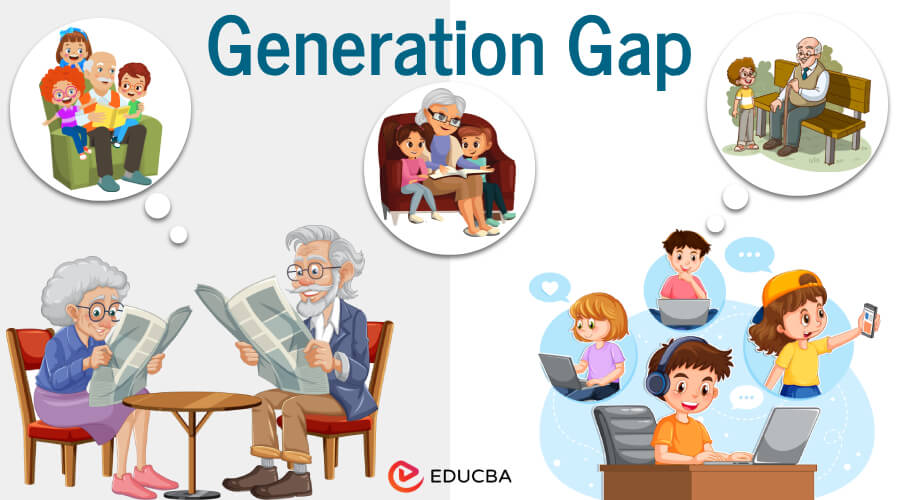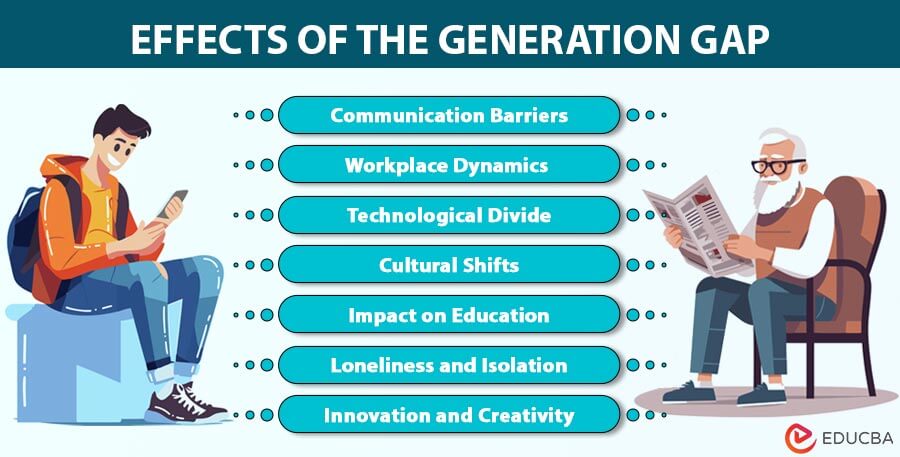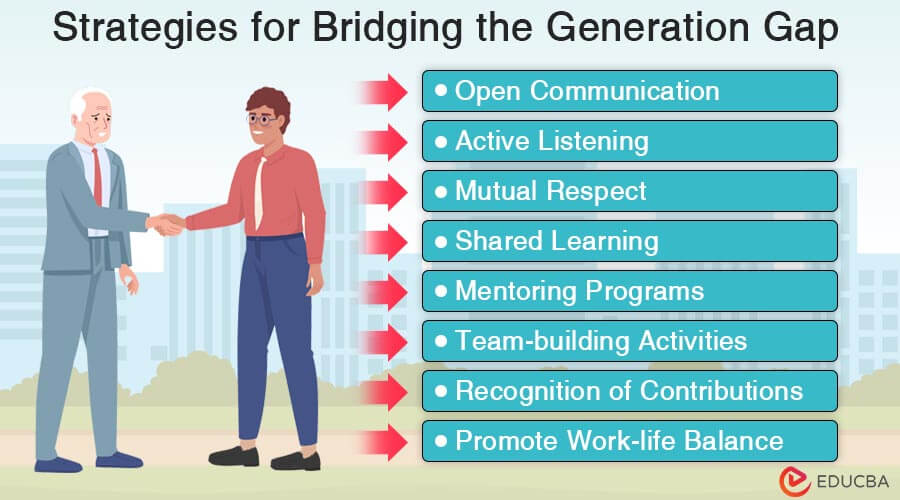Introduction to Generation Gap
The term “generation gap” encapsulates the ever-present divide between individuals of different age groups, fostering distinct worldviews shaped by unique experiences and societal influences. This gap has widened in today’s rapidly evolving world, fueled by technological advancements and cultural shifts. This essay delves into the causes and effects of the generation gap, exploring its implications on communication, relationships, and societal harmony. We aim to foster understanding and collaboration across generations by identifying strategies to bridge this gap. Recognizing the importance of addressing this divide is crucial for cultivating empathy, enhancing interpersonal connections, and promoting a harmonious coexistence in our diverse and dynamic global community.

Significance of Addressing the Generation Gap
The significance of addressing the generation gap lies in its profound impact on societal harmony, interpersonal relationships, and collective progress. It is imperative to comprehend and close this gap for several reasons:
- Cultural Continuity: Each generation contributes to the cultural fabric of society. Addressing the generation gap ensures the preservation of traditions, values, and historical perspectives, fostering a sense of continuity and connection across different age groups.
- Effective Communication: Improved communication between generations promotes understanding and minimizes misunderstandings. It enhances collaboration in various settings, from family environments to workplaces, creating a more cohesive and productive society.
- Innovation and Progress: Bridging the gap encourages the exchange of ideas and perspectives between generations. This cross-pollination of thoughts fosters innovation and ensures that societal progress benefits from the wisdom of the older generation and the fresh perspectives of the younger one.
- Family Dynamics: Within families, addressing the generation gap fosters stronger bonds. Open communication and mutual understanding create a supportive environment where family members can navigate challenges together, building a foundation for a healthier and more resilient family structure.
- Workplace Productivity: In professional settings, understanding and appreciating generational differences enhances teamwork, creativity, and productivity. A diverse workforce comprising individuals of different ages brings a wealth of skills, experiences, and ideas.
- Social Harmony: A society that actively addresses the generation gap tends to be more inclusive and harmonious. Recognizing the value of each generation’s contributions fosters empathy, reduces stereotypes, and creates an environment where individuals of all ages feel valued and understood.
Importance of Communication Across Age Groups
Effective communication across age groups fosters understanding, harmony, and collaboration in diverse societal contexts. The importance of such communication can be highlighted through several key points:
- Cultural Exchange: Interactions between different age groups facilitate the exchange of cultural knowledge, traditions, and values. This mutual sharing enhances cultural awareness and helps preserve heritage.
- Knowledge Transfer: Older generations possess valuable life experiences and skills, while younger generations bring fresh perspectives and technological proficiency. Open communication ensures a seamless knowledge transfer, fostering continuous learning and skill development.
- Workplace Dynamics: In professional settings, effective communication across age groups is essential for cohesive teamwork and increased productivity. It promotes a collaborative work environment where diverse skills and experiences contribute to innovative solutions.
- Social Cohesion: Communication bridges gaps in societal understanding. Engaging in conversations across generations reduces stereotypes and fosters empathy, creating a more cohesive and inclusive social fabric.
- Family Harmony: Within families, communication across age groups strengthens relationships. An open dialogue helps address generational differences, fostering a supportive environment where family members can navigate challenges together.
- Conflict Resolution: Misunderstandings arising from generational differences can lead to conflicts. Effective communication provides a platform to address and resolve these conflicts, promoting healthier relationships and stronger communities.
- Adaptability: The world is evolving rapidly, and each generation is experiencing unique challenges. Communicating across age groups facilitates adaptability as individuals learn from one another and collectively navigate societal changes.
How is the Generation Gap Evident?
The generation gap manifests in various ways, reflecting the differences in attitudes, values, lifestyles, and communication styles between individuals of different age groups. Evidence of the generation gap can be observed in the following areas:
- Communication Styles: Varied preferences in communication tools and styles are evident. Younger generations may favor digital communication, such as texting or social media, while older generations may prefer face-to-face or phone conversations.
- Technology Adoption: Differences in technology use highlight the generation gap. Younger generations tend to adopt new technologies earlier than older generations, who may be slower to adapt.
- Workplace Expectations: Distinct attitudes towards work are noticeable. Younger generations often seek work-life balance, flexibility, and purpose in their careers, while older generations may emphasize job stability and traditional work structures.
- Cultural References: Preferences for cultural references, entertainment, and pop culture vary between generations. Different age groups may have divergent tastes in music, movies, and forms of entertainment, reflecting their respective cultural influences.
- Values and Priorities: Generational gaps are evident in values and priorities. For instance, older generations may emphasize traditional values and family stability, while younger generations might prioritize individualism, social justice, and environmental sustainability.
- Attitudes Towards Authority: Attitudes towards authority figures and structures can differ. Younger generations may question authority and prefer collaborative decision-making, while older generations may value hierarchical structures and traditional forms of leadership.
- Political and Social Views: Generational differences are often pronounced in political and social views. Perspectives on issues such as civil rights, gender equality, and environmental responsibility may vary significantly between generations.
- Fashion and Lifestyle Choices: Clothing styles and lifestyle choices often reflect generational trends. Each generation tends to have its fashion preferences, reflecting broader societal shifts and cultural influences.
- Educational Approaches: Attitudes towards education and learning methods can differ. Younger generations may embrace technology in learning, while older generations may value traditional classroom settings and textbooks.
- Social Media Usage: The use of social media is a clear indicator of the generation gap. Younger individuals are often more active on platforms like Instagram, Snapchat, or TikTok, while older generations may engage more on platforms like Facebook or LinkedIn.
- Financial Perspectives: Perspectives on financial matters can vary. Younger generations may be more inclined towards experiences and saving for the future, while older generations may prioritize financial stability and homeownership.
- Approaches to Health and Wellness: Generational gaps are evident in attitudes towards health and wellness. Younger generations may prioritize holistic well-being, including mental health, while older generations may have different perspectives on healthcare and lifestyle choices.
Causes of the Generation Gap
Understanding the causes of the generation gap is crucial for addressing and bridging the divide between different age groups. Several factors contribute to this phenomenon:
- Technological Advancements: Rapid advancements in technology contribute significantly to the generation gap. Older generations may struggle to keep pace with the constantly evolving digital landscape, leading to a divide in communication styles and preferences.
- Cultural Shifts: Changes in societal norms, values, and cultural practices over time contribute to the generation gap. Each generation is shaped by the unique historical and cultural context in which they come of age, leading to divergent perspectives on various issues.
- Educational Disparities: Differences in educational opportunities and experiences can contribute to varying levels of knowledge and awareness across generations. Disparities in access to education can influence communication patterns and understanding of contemporary issues.
- Economic Factors: Economic conditions and opportunities can impact generational perspectives. For instance, economic downturns may shape the outlook of one generation in contrast to another that has experienced economic prosperity, leading to differing attitudes toward financial matters.
- Social Media Influence: Social media’s prevalence has significantly altered communication dynamics. Growing up in a digital era, younger generations may have distinct communication styles, social norms, and values compared to older generations, potentially causing a gap in understanding.
- Globalization: The interconnectedness of the world due to globalization exposes each generation to a rapidly changing global landscape. Varying responses to global issues and cultural influences contribute to differences in worldviews and priorities.
- Political and Social Movements: Participation in and reactions to political and social movements can shape generational perspectives. The experiences of living through significant historical events or participating in social change movements can lead to different outlooks on societal issues.
Effects of the Generation Gap
The generation gap manifests in various ways and has a range of effects on individuals, families, workplaces, and societies as a whole. Understanding these effects is crucial for addressing and mitigating the challenges associated with generational differences.
Here are some key impacts of the generation gap:
- Communication Barriers: Differences in communication styles, preferences, and technology use can lead to misunderstandings and communication breakdowns between generations.
- Misinterpretation and Stereotyping: Generational stereotypes may lead to misinterpretation of intentions and abilities, fostering negative perceptions and hindering collaboration.
- Workplace Dynamics: In the workplace, the generation gap can result in conflicts arising from differing work styles, expectations, and attitudes toward authority.
- Technological Divide: Older generations may experience a technological divide, feeling overwhelmed or excluded from the digital advancements embraced by younger generations.
- Family Conflicts: Within families, the generation gap can contribute to conflicts related to lifestyle choices, values, and expectations, affecting family dynamics.
- Resistance to Change: Older generations may resist embracing change, while younger generations may be more inclined towards innovation and adaptation, creating tension within various settings.
- Differing Perspectives on Social Issues: Generational gaps can lead to differing views on social and political issues, potentially creating divides in societal attitudes toward diversity, climate change, and social justice.
- Cultural Shifts: The generation gap contributes to cultural shifts as younger generations redefine societal norms, challenging established traditions and values.
- Impact on Education: Educational approaches and expectations may vary across generations, affecting learning styles, academic goals, and the perception of the value of education.
- Loneliness and Isolation: Older individuals may experience feelings of loneliness and isolation if they struggle to connect with younger family members or if societal changes alienate them.
- Innovation and Creativity: On the positive side, the generation gap can stimulate innovation and creativity as different perspectives come together, leading to new ideas and approaches.
- Social Harmony: When the generation gap is addressed positively, it can contribute to social harmony by fostering understanding, empathy, and appreciation for diverse viewpoints.
Strategies for Bridging the Generation Gap
Bridging the generation gap requires intentional efforts to foster understanding, open communication, and collaboration among different age groups.
Here are key strategies to bridge the generation gap:
- Open Communication: Encourage intergenerational communication to promote understanding. Establish a safe space for open expression of perspectives and concerns.
- Active Listening: Promote active listening skills to ensure that individuals from all age groups feel heard and valued. This helps in avoiding misunderstandings and building stronger connections.
- Mutual Respect: Emphasize the importance of mutual respect. Recognize and value the distinct viewpoints, experiences, and contributions that every generation has to offer.
- Shared Learning: Facilitate opportunities for shared learning experiences. Older generations can share their experiences and knowledge, while younger generations can offer their technological expertise and insights.
- Mentoring Programs: Establish mentoring programs that pair individuals from different age groups. This allows for transferring knowledge and skills, fostering professional and personal growth.
- Reverse Mentoring: Encourage reverse mentoring, where younger individuals mentor older counterparts, particularly in areas related to technology, social media, and contemporary trends.
- Team-building Activities: Organize team-building activities that promote collaboration and communication. These activities can break down barriers and create a sense of unity among individuals of different generations.
- Generational Diversity Training: Provide training programs on generational diversity to increase awareness and understanding of each generation’s unique characteristics and perspectives.
- Flexible Work Environments: Implement flexible work environments that accommodate different work styles and preferences. This fosters a culture of inclusivity, allowing individuals of all ages to thrive.
- Recognition of Contributions: Recognize and celebrate the contributions of individuals from all age groups. This acknowledgment helps build a positive and inclusive culture where everyone feels valued.
- Cross-generational Collaboration Projects: Encourage collaboration on projects that involve individuals from different age groups. This promotes teamwork, encourages exchanging ideas, and leads to innovative solutions.
- Promote Work-life Balance: Recognize and address generational differences in attitudes toward work-life balance. Establish regulations that uphold a balanced approach and address the different requirements of different age groups.
Real-life Examples
Real-life examples of successful efforts to bridge the generation gap provide valuable insights into the positive outcomes of fostering intergenerational understanding and collaboration. Here are a few examples:
- Corporate Mentorship Programs: Many forward-thinking companies have implemented mentorship programs that pair experienced employees with younger counterparts. This allows for the exchange of knowledge, skills, and perspectives. For instance, multinational corporations like IBM and General Electric have established successful mentorship initiatives.
- Tech Companies Embracing Diversity: Silicon Valley companies, known for their emphasis on innovation, have recognized the benefits of a diverse workforce. Tech giants like Google, Apple, and Microsoft actively promote intergenerational collaboration, recognizing that a mix of experienced and younger talent leads to more creative and effective solutions.
- Community Volunteer Initiatives: Volunteer organizations often bring together individuals from different age groups to work toward common goals. For example, community service projects, such as environmental cleanup efforts or charitable initiatives, allow people of all ages to collaborate and make a positive impact.
- Intergenerational Learning in Education: Educational institutions have implemented programs encouraging intergenerational learning. In some schools, older adults serve as mentors or volunteers, sharing their life experiences and skills with students. Conversely, students may assist older adults with technology or provide tutoring services.
- Family Businesses Transitioning Leadership: Successful family businesses often prioritize a smooth leadership transition between generations. Open communication, mentorship, and a shared vision for the future contribute to the longevity and success of these enterprises. Examples include businesses in various industries, from retail to manufacturing.
- Government Initiatives for Age-Friendly Communities: Some local governments have implemented initiatives to create age-friendly communities. These programs ensure that public spaces, services, and policies accommodate the needs and preferences of individuals of all ages, fostering inclusivity and community cohesion.
- Inter-generational Housing Solutions: Innovative housing solutions bring together people of different ages. Examples include co-housing projects where families, young professionals, and seniors live nearby, creating a supportive and diverse living environment.
- Technology Training for Seniors: Non-profit organizations and community centers offer technology training programs for seniors, bridging the digital divide. Initiatives like these empower older individuals to stay connected with younger generations and the broader community through digital means.
- Cultural Exchange Programs: Programs facilitating cultural exchange between generations contribute to mutual understanding. These initiatives may involve storytelling, art workshops, or collaborative events that bring together individuals with different cultural backgrounds and experiences.
Conclusion
Addressing the generation gap is a matter of understanding differences and a crucial step toward building more robust, more cohesive societies. By recognizing each generation’s unique perspectives, values, and contributions, we pave the way for effective communication, collaboration, and cultural exchange. Embracing generational diversity enables us to harness the strengths of varied experiences, fostering innovation, empathy, and harmonious coexistence. In a world marked by rapid change, bridging the generation gap is necessary and an opportunity to create richer, more resilient communities that thrive on all age groups’ collective wisdom and dynamism.


